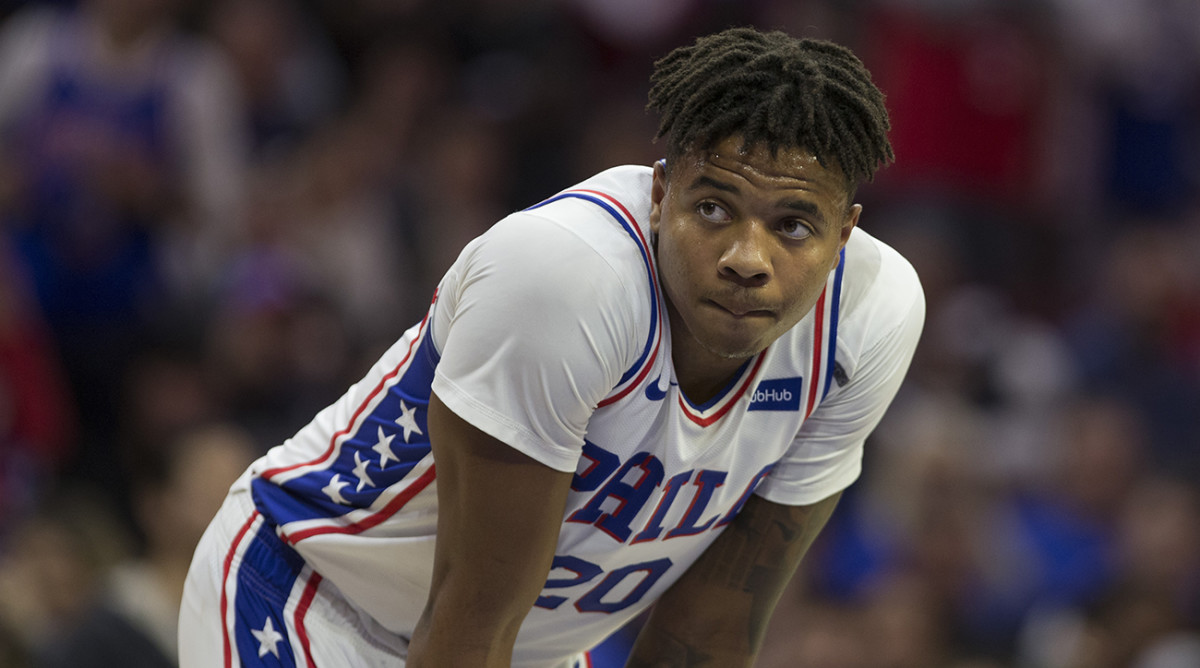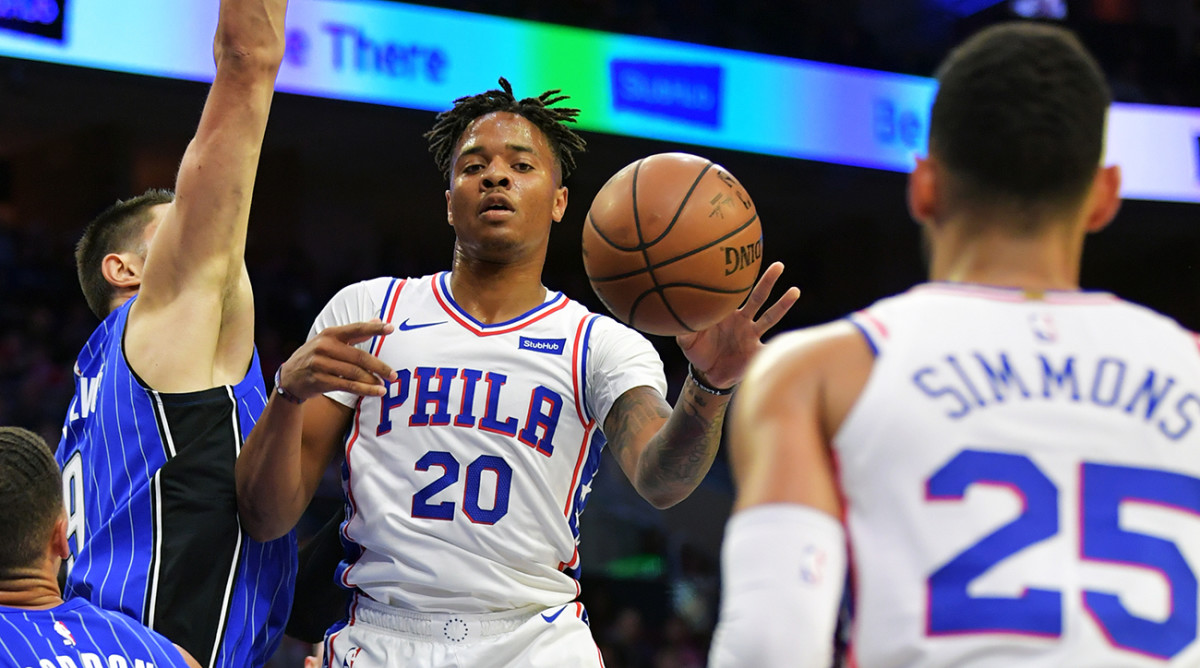The Markelle Fultz Problem Isn't Going Away

Monday night in Philadelphia, Markelle Fultz had one of the best games of his career. He scored 16 points (7-of-16 shooting) and added seven assists in a blowout win against the Hawks. With the game out of reach in the third quarter, he hit a three that drove the Wells Fargo Center crazy. A few plays later, he exploded down the lane for a one-handed dunk over a Hawks wing who was a step slow with help defense. All of this was an encouraging sign. Fultz looked comfortable and the game came easily to him. It was a reminder that the Sixers aren't crazy for trying to make this work.
The problem is that even the best game of Fultz's career came after a first quarter that saw Atlanta's defense ignoring Fultz and using Kent Bazemore to harass the other four players on the court. It wasn't a coincidence that he Sixers struggled early. There was no space for Ben Simmons and Dario Saric to operate, and after a slow start, the slog continued throughout the first two quarters. They eventually headed to halftime tied with the Hawks. It was only in the first half of the third quarter—with Fultz on the bench while J.J. Redick played with the starters—that Philadelphia took control of the game and looked like one of the best teams in the league.

The difference between how Fultz started and how he finished is what has haunted the Sixers for the past month. Fultz definitely has moments where he reminds everyone why he was the No. 1 pick—a combination of size and speed, coupled with the ability to break defenses down off the dribble and, in theory, hit from the perimeter. The problem is that between those encouraging stretches, there are extended struggles that don't necessarily help Fultz, and actively hurt the team.
Opponents don't respect his jumper, and nor should they. The odd three-point make notwithstanding, Fultz still can't shoot. He was 1-5 from three Monday night, and in most games, he's not shooting from outside at all. Every time he's on the court, it becomes easier to guard players like Ben Simmons and Joel Embiid. The Hawks, coached by former Philly assistant Lloyd Pierce, were maybe the most disrespectful opponent the Sixers have seen thus far. There will be others who mimic this blueprint:
This is a problem that's not going away. And really, if the topic is Fultz in Philly, there are three problems baked into the discussion.
First there's Fultz and the state of his game. Whether last year's problems were mental or physical or both, he still doesn't look right. When he shares the court with the starters, he's either reluctant to shoot, or he's throwing his body into traffic without a real plan. While it's been great to see his teammates support him and borderline surreal to see the reception he gets at Sixers home games, none of it has been enough to change what happens on the court.
This is hard. Most of the time we watch players as they go through some career-altering struggle, we only see them again when they've come through the experience poised to redeem themselves. We're familiar with that redemption narrative because we rarely have to consider the alternative. The players who can't put it back together generally don't make it back to the spotlight. In Fultz's case, we're watching him try to put his game back together on national television, in a lineup that doesn't suit him, for a team that desperately needs him. For players and coaches and even fans, this is a once-in-a-generation conundrum that's not fun for anyone to think too hard about. It's nobody's fault, but that doesn't make it any easier. And obviously, the ongoing struggles are toughest for Fultz.
There's also the Sixers rotation. Right now the Sixers have Fultz in the starting lineup because it benefits everyone—coaches, management, players—to know exactly what's possible with this lineup in the immediate future. Playing Fultz meaningful minutes is the only way to get a real answer.
Klay Thompson Scores 52, and Now the Warriors’ Death Star is Fully Operational
So far, the experiment is not going well. While last year's starting five (Embiid, Simmons, Dario Saric, Robert Covington, J.J. Redick) has a net-rating of 17.5, replacing Redick with Fultz has resulted in a lineup with a net-rating of -36.5 through six games. When he shares the floor with Simmons in any lineup, their net-rating is -17.6. With Dario Saric, another player who needs space to thrive, the number becomes -18.6. None of which is to say that Fultz is completely hopeless; he's just not an ideal fit for a starting lineup that's already working with a few of the league's more unconventional stars.
"Every time we get on the floor we’re trying to get more comfortable,” Fultz said of his fit next to Simmons. “We’ve only been out there together but so much. We’re taking it game by game and every time we get out there we’re looking forward to growing as a team, growing as teammates and getting better.”
“Although it’s early days, I’m aware of the numbers,” Sixers coach Brown said Monday. “You could just keep burying your head in the sand and just keep doing it and doing it—you could do that. I choose to walk that line of trying to grow it and win. That’s part of my challenge.”

It's worth continuing the experiment, but as the struggles continue, it's also worth considering alternatives. The second half of Monday night's Hawks game highlighted a role that could make more sense. Off the bench, on his own and away from Simmons or Saric, Fultz can help. Next to shooters like Landry Shamet and J.J. Redick, with Joel Embiid inside, Fultz has room to get into the lane and be aggressive. Playing on the ball helps him reconnect with the best version of his game, and everything looks more natural. He's not going to suddenly become a superstar playing spot minutes off the bench, but it's an opportunity to build confidence and possibly build trade value. For both the Sixers and Fultz, that blueprint seems like a better bet than throwing him out with the starters and hoping that he magically becomes James Harden next to Ben Simmons.
The third problem within the Fultz discussion is that the team still need real help next to Simmons, and finding an answer there is its own riddle. This is why the Fultz situation is so maddening. As a draft prospect, his shooting and ability to create off the dribble made him a dream fit next to Simmons. Those skills are still exactly what the Sixers need. The same way Harden pick-and-rolls once opened up the floor for Russell Westbrook and the Thunder, Fultz could have been a perfect bridge between Simmons and Embiid. As that dream becomes less realistic now, the rest of the future becomes more uncertain.
NBA Power Rankings: Cavaliers Continue to Sink Without LeBron James
In the short term, Redick can slide back into the starting lineup and give the Sixers a chance against anyone. The question is what happens next. Philly's free agent bet on Jerryd Bayless fizzled almost as soon as he arrived in Philadelphia two summers ago. Their first round pick in 2018 (Zhaire Smith) is hurt and hasn't seen the floor. In 2017, they used the 25th pick to take Anžejs Pasečņiks one spot in front of Josh Hart, a Villanova star who would've been perfect next to Simmons.
Going forward, they probably won't have many avenues to land another star, in part because they forfeited an extra lottery pick to land Fultz in that same 2017 draft. There will be cap space waiting next summer, but the options are already dwindling. Klay Thompson probably isn't leaving Golden State, and if Khris Middleton leaves Milwaukee, there will be at least five other teams competing to sign him. Meanwhile, Redick will be a 35 year-old free agent next summer. Regardless of what he commands on the open market, it's not clear how much longer he can play starter's minutes on a team that wants to contend for the next decade.
The Sixers have the talent to make the whole league pay attention to the next steps here, and contending for a decade isn't a crazy dream. But if the goal is to compete with the top of the league, the Sixers have to find another star to alleviate spacing problems next to Ben Simmons, not compound them. Watching Fultz for these first few weeks, you may not see a solution, but we are certainly getting a clearer look at what the problem is.
